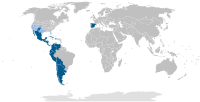
Photo from wikipedia
This article examines the input to Argentinian Spanish-learning children from low and middle socioeconomic status (SES). It aims to determine whether the vocabulary composition (nouns and verbs) of their input… Click to show full abstract
This article examines the input to Argentinian Spanish-learning children from low and middle socioeconomic status (SES). It aims to determine whether the vocabulary composition (nouns and verbs) of their input varies as a function of SES, the addressee and other contextual variables such as the type of activity and the pragmatic orientation of the utterances. Thirty children (mean: 14.3 months) and their families were audio-recorded for four hours and the middle two hours were analyzed using Computerized Language Analysis (CLAN). The nouns and verbs in child-directed speech (CDS) and overheard speech (OHS) were identified using the CLAN’s part of speech tagger MOR Morphosyntactic Analysis. Regression analyses showed effects of: (a) SES and addressee on the proportion of noun types and tokens; (b) the type of activity and the pragmatic orientation of the utterances on the proportion of nouns in CDS; (c) SES and type of activity on the proportion of entity and action-oriented utterances. These findings reveal that given the complexity of children’s home environments it is crucial to consider these social and contextual dimensions to account for the distribution of different lexical categories. How they are distributed in the input likely influences the developmental course of vocabulary acquisition.
Journal Title: First Language
Year Published: 2020
Link to full text (if available)
Share on Social Media: Sign Up to like & get
recommendations!